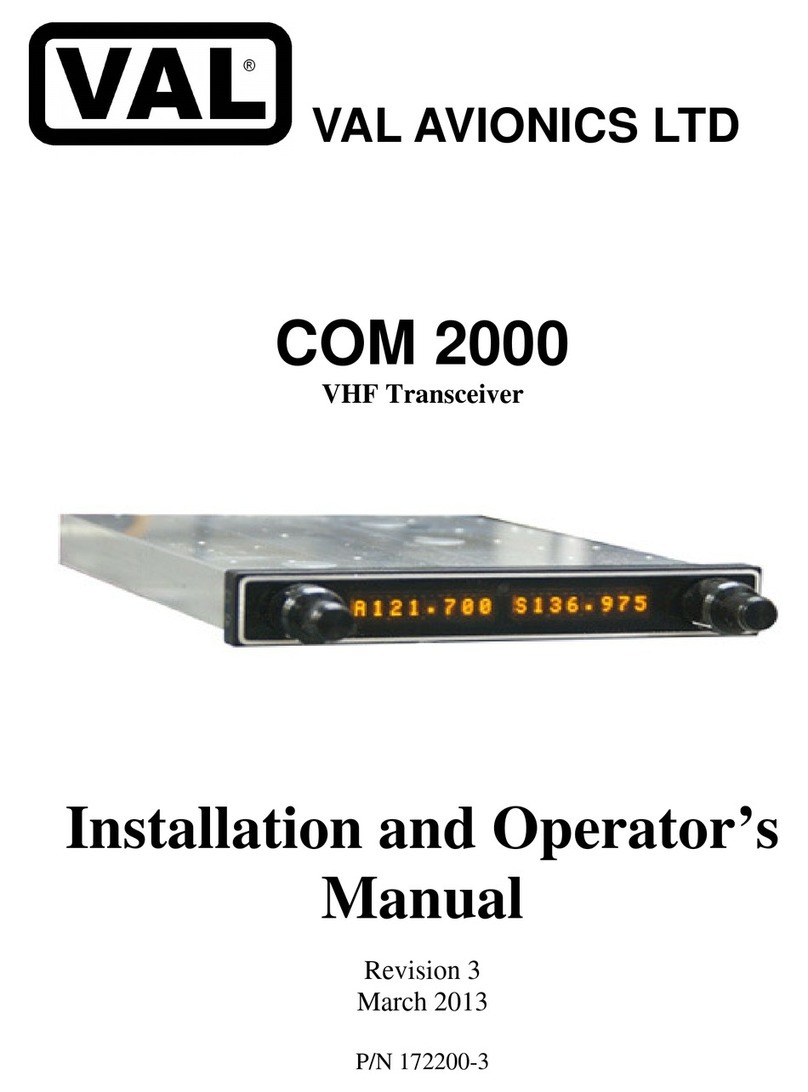
V A L A V I O N I C S L T D
C O M 2 0 0 0 R – V H F T R A N S C E I V E R
I N S T A L L A T I O N A N D O P E R A T O R ’ S M A N U A L
Revision 3 Page 3 of 27
March 2013
Table of Contents
1
SECTION I - GENERAL INFORMATION .....................................................................................................4
1.1
INTRODUCTION...........................................................................................................................................4
1.2
SCOPE ............................................................................................................................................................4
1.3
EQUIPMENT DESCRIPTION.......................................................................................................................4
1.4
FCC .................................................................................................................................................................5
1.5
SPECIFICATIONS .........................................................................................................................................6
1.6
EQUIPMENT SUPPLIED ..............................................................................................................................7
1.7
EQUIPMENT REQUIRED BUT NOT SUPPLIED .......................................................................................7
1.8
LICENSE REQUIREMENTS.........................................................................................................................7
2
SECTION II - INSTALLATION .......................................................................................................................8
2.1
GENERAL INFORMATION .........................................................................................................................8
2.1.1
Scope .....................................................................................................................................................8
2.2
UNPACKING AND INSPECTION................................................................................................................8
2.3
EQUIPMENT INSTALLATION PROCEDURES .........................................................................................8
2.3.1
Cooling Requirements ...........................................................................................................................8
2.3.2
Mounting Requirements ........................................................................................................................8
2.3.3
Wire Harness Fabrication ......................................................................................................................8
2.3.4
COM 2KR Installation...........................................................................................................................9
2.4
POST INSTALLATION CHECK...................................................................................................................9
2.4.1
Operational Check .................................................................................................................................9
2.4.2
Final Inspection .....................................................................................................................................9
2.5
LIMITATIONS ...............................................................................................................................................9
3
SECTION III - OPERATION ..........................................................................................................................10
3.1
GENERAL INFORMATION .......................................................................................................................10
3.1.1
Scope ...................................................................................................................................................10
4
SECTION IV - WARRANTY AND SERVICE ..............................................................................................11
4.1
LIMITED WARRANTY ..............................................................................................................................11
4.2
SERVICE ......................................................................................................................................................11
5
Appendix A – INSTALLATION DRAWINGS AND CONNECTOR LAYOUT.........................................12
6
Appendix B – WIRING DIAGRAMS ..............................................................................................................14
7
Appendix C – Certifications .............................................................................................................................15
7.1
FAA Acceptability: .......................................................................................................................................15
8
Appendix D – INSTRUCTIONS FOR CONTINUED AIRWORTHINESS ................................................16
8.1
MAINTENANCE INSTRUCTIONS............................................................................................................16
9
Appendix E – RS-232 Command Interface .....................................................................................................17
9.1
Input Commands ...........................................................................................................................................17
9.2
Output Messages ...........................................................................................................................................17
9.3
Data Format...................................................................................................................................................17
9.4
Default Message Output................................................................................................................................17
9.5
Message Formats...........................................................................................................................................18
9.6
Message Definitions......................................................................................................................................19
9.6.1
Input Messages ....................................................................................................................................19
9.6.2
OUTPUT MESSAGES........................................................................................................................23
Table 1: Specifications .................................................................................................................................................6
Table 2: Equipment Supplied .......................................................................................................................................7
Table 3: Equipment Not Supplied ................................................................................................................................7
Table 4: Rear Connector Pin Functions......................................................................................................................13
Table 5 - Data Output Requests...................................................................................................................................19
Figure 1: Physical Dimensions ...................................................................................................................................12
Figure 2: P1 Connector Pin Out..................................................................................................................................12
Figure 3: COM 2K Basic Wiring Diagram..................................................................................................................14





























